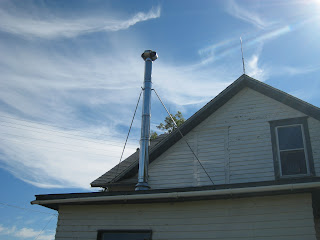I was watching a programme on TV where children were being asked where their food comes from. I wasn't so much horrified by the answers as plain sad as one by one the children answered the question by naming their local grocery store. When pressed to answer where the store got it from, there was either silence or that the store made it out back. Entire generations of families have never tasted a home-grown, chemical-free, sun-ripened tomato, never mind other vegetables. Increasingly it seems fewer people actually care about what went into their food, how far it has travelled or whether the farmer received fair payment for it....farmer? what farmer? Not everyone has the room for a garden but do have access to a farmers' market, so the flavours of fresh vegetables are available without the prices of supermarket organic.
One easy product anyone can make at home is yoghurt, it takes little effort and no special tools, you can even make it using store bought milk if you don't have access to fresh milk. In this house, I am the expert at eating the stuff, while Anita is the yoghurt-maker. I can tell you how wonderful it is, but she can tell you how to make it.
Edith
Welcome to Homemade Yoghurt 101:
As you become enthused about the process of making the yoghurt you love, having it available almost any time you want/need it, and experimenting with its use, bear in mind that this is a truly simple food. You don't need to invest large amounts of money for ingredients or equipment! Yes, I have had and used a yoghurt maker for over 30 years, but that little appliance is not a necessity at all! Do you have a quart-sized thermos bottle? OK, so you don't...do you perhaps know someone who does have a spare one? Is it remotely possible that this soul owes you a little favor or can be intimidated until he/she is willing to lend it to you? Good! You are ready to start!
Fill that nice borrowed thermos bottle with hot water. This should NOT be boiling water as that is too warm for the yoghurt cultures and will probably kill it. (Not a good thing.) Just set that thermos out of the way for now while we get serious with some milk.
As I said, this is a truly simple food and originated when folks needed a way of preserving excess milk for later use. Please, oh, please do NOT rush out and buy rich whole milk or cream! The reason for this warning is basic: it won't make the kind of yoghurt that you want . In fact, it may hardly thicken at all, to say nothing of reaching that lovely pudding consistency that we have come to love. If at all possible, try to use reconstituted powdered milk. I have used skim milk and found that the yoghurt was just about right, but it was much better when I added 3 tablespoons of powdered milk to it. Straight powdered milk is absolutely the best!
Now I need to give you a couple of alternatives to start making your own yoghurt. I mentioned the option of (a)using skim milk that has approximately 3 Tbsp of powdered milk added and (b) using reconstituted powdered milk. Each option requires that the milk be heated.
If I am using the skim milk option, I measure 3 3/4 cups of milk into a Pyrex measuring cup and heat it in the microwave (see? I told you it was easy!) for about 3 minutes. If your microwave has a "beverage" setting, go ahead and use it. You do not need to scald the milk. Most of what we use today is already pasteurized, you know. Imagine the temperature you would need for a baby, about 85-90F. That is what you want. You must avoid having it too hot. After heating, just stir in about 3Tbsp of powdered milk.
If, however, you choose the straight powdered milk option, feel free to just run your tap water as hot as it gets and then add the powdered milk. I like to use about a cup and a half of milk powder for a quart.
Now comes the exciting part! Buy a large carton of good quality plain yoghurt, such as Activia. I have used a variety of brands and types and find that Activia is as good as it gets. You do NOT need to go to the health food store and purchase the expensive packets of cultures. Vanilla flavoring is okay, if you have no other option. I would advise against the fruit-flavored ones as the yoghurt is a sort of odd color when it comes out, even though it is perfectly fine to eat, of course. Drop about 3 heaping tablespoons of your Activia (hereafter known as the 'starter') into your warm milk and mix it thoroughly together with a whisk. This ensures even distribution and avoids little clumps in the milk.
Remember that thermos? We need it now! Pour out that hot water that primed the bottle for you and then carefully pour all of your warm milk, powdered milk, and yoghurt mixture into it. See? Now you know why you used a measuring cup to heat and mix the milk! Immediately put the stopper back on the bottle and then just set it out of the way on the cupboard for about 12 hours. Bear in mind that the world will not come to an end if you don't time this process precisely! I have forgotten my yoghurt for a while....that is to say it sat for about 18 hours! It was still good stuff!
So now you have about a quart of good home-made yoghurt. If you are planning on having it as your breakfast or as a snack, you will probably want to cool it and then add fruit and some sweetening. I like blueberries and they are very good for us, so I buy the largest bag of store brand frozen blueberries. I thaw about 1 1/2-2 cups and then add about 1/3 cup of sugar. I have also tried some canned fruits, even used some canned pie filling. It was edible, but not as nice as the straight fruit. I have used frozen strawberries and even mixed fruits. The mixtures that have melon or berries with large seeds are not as pleasant as I would like, though.
If you are of the adventurous spirit and would like to try making a cream cheese, nothing could be easier. Make the yoghurt as described above and then pour it into a colander that is lined with several (yes, several) layers of the webby-type of cheese cloth that you can find in the fabric department. Let the whey drain out for a couple of hours...place the colander over a bowl or just drain it into the sink if you like. You will notice that the yoghurt very soon becomes much dryer. When it isn't draining quite so quickly anymore (drip, drip, drip), tie the corners together and twist the top of the 'bag' with a stick...I have used the handle of a wooden spoon. Then, just let it keep on dripping till it quits.
Now you have not only made your own yoghurt, you have made your own cream cheese!! Aren't you clever! At this point, you can be as creative as you wish. To this cream cheese, you may add any seasoning or herbs you choose. Some suggestions might be minced garlic, minced chives, onion powder, thyme, parsley...the list just goes on and on. Feel free to substitute your cream cheese in that favorite cheese ball recipe. Take it with you to the office and impress your friends! The possibilities are endless and they are each delicious!
One last note: make sure you save a cup or so of your unflavored yoghurt to use as starter for the next batch. I usually have one batch cooling and one batch in the making. We eat lots of yoghurt as there is nothing much better for breakfast than a bowl of bluberry yoghurt with a slice of toasted home-made whole wheat bread!
Anita






























